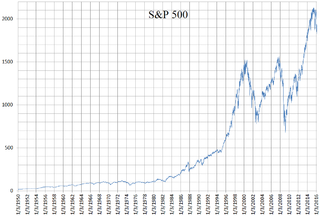
The Standard and Poor's 500, or simply the S&P 500, is a stock market index tracking the stock performance of 500 of the largest companies listed on stock exchanges in the United States. It is one of the most commonly followed equity indices and includes approximately 80% of the total market capitalization of U.S. public companies, with an aggregate market cap of more than $43 trillion as of January 2024.

In finance, an exchange rate is the rate at which one currency will be exchanged for another currency. Currencies are most commonly national currencies, but may be sub-national as in the case of Hong Kong or supra-national as in the case of the euro.
In macroeconomics, hard currency, safe-haven currency, or strong currency is any globally traded currency that serves as a reliable and stable store of value. Factors contributing to a currency's hard status might include the stability and reliability of the respective state's legal and bureaucratic institutions, level of corruption, long-term stability of its purchasing power, the associated country's political and fiscal condition and outlook, and the policy posture of the issuing central bank.
In finance, a foreign exchange option is a derivative financial instrument that gives the right but not the obligation to exchange money denominated in one currency into another currency at a pre-agreed exchange rate on a specified date. See Foreign exchange derivative.
A currency pair is the quotation of the relative value of a currency unit against the unit of another currency in the foreign exchange market. The currency that is used as the reference is called the counter currency, quote currency, or currency and the currency that is quoted in relation is called the base currency or transaction currency.

The trade-weighted effective exchange rate index, a common form of the effective exchange rate index, is a multilateral exchange rate index. It is compiled as a weighted average of exchange rates of home versus foreign currencies, with the weight for each foreign country equal to its share in trade. Depending on the purpose for which it is used, it can be export-weighted, import-weighted, or total-external trade weighted.
A capitalization-weightedindex, also called a market-value-weighted index is a stock market index whose components are weighted according to the total market value of their outstanding shares. Every day an individual stock's price changes and thereby changes a stock index's value. The impact that individual stock's price change has on the index is proportional to the company's overall market value, in a capitalization-weighted index. In other types of indices, different ratios are used.
The trade-weighted US dollar index, also known as the broad index, is a measure of the value of the United States dollar relative to other world currencies. It is a trade weighted index that improves on the older U.S. Dollar Index by incorporating more currencies and yearly rebalancing. The base index value is 100 in January 1997. As the U.S. Dollar gains value the index increases.

The U.S. Dollar Index is an index of the value of the United States dollar relative to a basket of foreign currencies, often referred to as a basket of U.S. trade partners' currencies. The Index goes up when the U.S. dollar gains "strength" (value) when compared to other currencies.
There are two different types of world currency unit in use today that have different origins and usages.
The effective exchange rate is an index that describes the strength of a currency relative to a basket of other currencies. Typically it is calculated using geometric weighting. It can be computed using the USD as a numeraire. This means the constituent exchange rates are all first defined vis-a-vis the USD.

In finance, a stock index, or stock market index, is an index that measures the performance of a stock market, or of a subset of a stock market. It helps investors compare current stock price levels with past prices to calculate market performance.

A currency basket is a portfolio of selected currencies with different weightings. A currency basket is commonly used by investors to minimize the risk of currency fluctuations and also governments when setting the market value of a country's currency.
The effective exchange rate index describes the strength of a currency relative to a basket of other currencies. Although typically the basket is trade weighted, there are others besides the trade-weighted effective exchange rate index.
The Wall Street Journal Dollar Index is an index of the value of the U.S. dollar relative to 16 foreign currencies.
The Euro Currency Index (EUR_I) represents the arithmetic ratio of four major currencies against the Euro: the American dollar, British sterling, the Japanese yen and the Swiss franc. All ratios are expressed in units of currency per Euro. The index was launched in 2004 by the exchange portal Stooq.com. Underlying are 100 points on 4 January 1971. Before the introduction of the European single currency on 1 January 1999 an exchange rate of 1 euro = DM 1.95583 was calculated.
VN30 Equal Weight Index tracks the total performance of the top 30 large-cap, liquid stocks listed on the Ho Chi Minh City stock exchange along with two popular indices in Vietnam: VN Index and VN30 Index. All index constituents are equal-weighted to help investors deal with liquidity, foreign ownership and state-owned enterprise constraints when investing in Vietnam.

Metropolitan Stock Exchange of India Limited (MSE) is a stock exchange regulated by Securities and Exchange Board of India (SEBI). The Exchange was notified of a "recognized stock exchange" under Section 2(39) of the Companies Act, 1956 by the Ministry of Corporate Affairs, Govt. of India, on December 21, 2012. The exchange's shareholders are some of India's top public sector banks, private sector banks, and domestic financial institutions.







